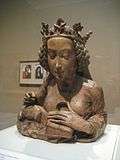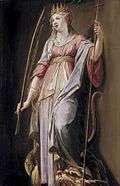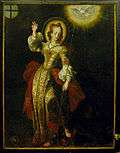Margaret the Virgin
| Saint Margaret of Antioch St Marina the Great Martyr | |
|---|---|
 St. Marina the Great Martyr. An illustration in her hagiography printed in Greece depicting her beating a demon with a hammer. Date on the picture: 1858. | |
| Virgin-Martyr and Vanquisher of Demons | |
| Born |
289 Antioch, Pisidia |
| Died | 304 (aged 15) |
| Feast | July 20 in Roman Catholic Church, July 20 in Anglican Church -;[1] July 17 in the Eastern Church |
| Attributes | slain dragon (Western depictions); hammer, defeated demon (Eastern Orthodox depictions) |
| Patronage | childbirth, pregnant women, dying people, kidney disease, peasants, exiles, falsely accused people; Lowestoft, England; Queens' College, Cambridge; nurses; Sannat and Bormla, Malta |
Catholic cult suppressed | 1969[2] by Pope Paul VI |
Margaret, known as Margaret of Antioch in the West, and as Saint Marina the Great Martyr (Greek: Ἁγία Μαρίνα, Hagía Marína) in the East, is celebrated as a saint by the Roman Catholic and Anglican Churches on July 20 and on July 17 in the Orthodox Church. Her historical existence has been questioned. She was declared apocryphal by Pope Gelasius I in 494, but devotion to her revived in the West with the Crusades. She was reputed to have promised very powerful indulgences to those who wrote or read her life, or invoked her intercessions; these no doubt helped the spread of her cultus.[3]
Narrative
According to the version of the story in Golden Legend, she was a native of "Antioch" and the daughter of a pagan priest named Aedesius. Her mother having died soon after her birth, Margaret was nursed by a Christian woman five or six leagues from Antioch. Having embraced Christianity and consecrated her virginity to God, Margaret was disowned by her father, adopted by her nurse, and lived in the country keeping sheep with her foster mother (in what is now Turkey).[4] Olybrius, Governor of the Roman Diocese of the East, asked to marry her, but with the demand that she renounce Christianity. Upon her refusal, she was cruelly tortured, during which various miraculous incidents occurred. One of these involved being swallowed by Satan in the shape of a dragon, from which she escaped alive when the cross she carried irritated the dragon's innards. The Golden Legend describes this last incident as "apocryphal and not to be taken seriously" (trans. Ryan, 1.369). She was put to death in AD 304.
As Saint Marina, she is associated with the sea, which "may in turn point to an older goddess tradition," reflecting the pagan divinity, Aphrodite.[5]
Veneration
The Eastern Orthodox Church knows Margaret as Saint Marina, and celebrates her feast day on July 17. She has been identified with Saint Pelagia, "Marina" being the Latin equivalent of the Greek "Pelagia" who - according to her hagiography by James, the deacon of Heliopolis - had been known as "Margarita" ("Pearl"). We possess no historical documents on St. Margaret as distinct from St. Pelagia. The Greek Marina came from Antioch in Pisidia (as opposed to Antioch of Syria), but this distinction was lost in the West.
The cultus of Saint Margaret became very widespread in England, where more than 250 churches are dedicated to her, most famously, St. Margaret's, Westminster, the parish church[6] of the British Houses of Parliament in London. Some consider her a patron saint of pregnancy. In art, she is usually pictured escaping from, or standing above, a dragon.
She is recognized as a saint by the Roman Catholic Church, being listed as such in the Roman Martyrology for July 20.[7] She was also included from the twelfth to the twentieth century among the saints to be commemorated wherever the Roman Rite was celebrated,[8] but was then removed from that list because of the entirely fabulous character of the stories told of her.[9] Margaret is one of the Fourteen Holy Helpers, and is one of the saints who spoke to Joan of Arc.
Images
 Saint Margaret and the Dragon, alabaster with traces of gilding, Toulouse (ca 1475). (Metropolitan Museum of Art). |  Reliquary Bust of Saint Margaret of Antioch. Attributed to Nikolaus Gerhaert (active in Germany, 1462 - 73). |  Saint Margaret of Antioch, limestone with paint and gilding, Burgos, (ca. 1275-1325). (Metropolitan Museum of Art). |  St. Margaret as a shepherdess by Francisco de Zurbarán, (1631). |  St. Margaret of Antioch by Peter Candid (second half of the 16th century) |  Margaret the Virgin on a painting in the Novacella Abbey, Neustift, South Tyrol, Italy. |  Saint Margaret attracts the attention of the Roman prefect, by Jean Fouquet, (from an illuminated manuscript). |
See also
- St Marina the Monk and St Pelagia, both of whom are sometimes conflated or confused with Margaret
References
Citations
- ↑ Book of Common Prayer
- ↑ Mary Clayton; Hugh Magennis (15 September 1994). The Old English Lives of St. Margaret. Cambridge University Press. p. 3. ISBN 978-0-521-43382-2.
- ↑ "Margaret of Antioch" The Oxford Dictionary of Saints. David Hugh Farmer. Oxford University Press 2003. Oxford Reference Online. Oxford University Press. Accessed 16 June 2007
- ↑ MacRory, Joseph. "St. Margaret." The Catholic Encyclopedia. Vol. 9. New York: Robert Appleton Company, 1910. 1 Mar. 2013
- ↑ Gábor Klaniczay; Éva Pócs; Eszter Csonka-Takacs (2006). Christian Demonology and Popular Mythology. Central European University Press. p. 124. ISBN 978-963-7326-76-9.
- ↑ Westminster Abbey. "St. Margaret's, Westminster Parish details". Archived from the original on 2008-03-05. Retrieved 2008-05-03.
- ↑ Martyrologium Romanum (Libreria Editrice Vaticana, 2001 ISBN 88-209-7210-7)
- ↑ See General Roman Calendar as in 1954
- ↑ Calendarium Romanum (Libreria Editrice Vaticana, 1969), p. 130
Bibliography
- Acta Sanctorum, July, v. 24—45
- Bibliotheca hagiographica. La/ma (Brussels, 1899), n. 5303—53r3
- Frances Arnold-Forster, Studies in Church Dedications (London, 1899), i. 131—133 and iii. 19.
 This article incorporates text from a publication now in the public domain: Chisholm, Hugh, ed. (1911). "article name needed". Encyclopædia Britannica (11th ed.). Cambridge University Press.
This article incorporates text from a publication now in the public domain: Chisholm, Hugh, ed. (1911). "article name needed". Encyclopædia Britannica (11th ed.). Cambridge University Press.
External links
| Wikimedia Commons has media related to Saint Margaret of Antioch. |
- Saint Margaret and the Dragon links
- Middle English life of St. Margaret of Antioch, edited with notes by Sherry L. Reames
- Book of the Passion of Saint Margaret the Virgin, with the Life of Saint Agnes, and Prayers to Jesus Christ and to the Virgin Mary (English) (Latin) (Italian)
- Catholic Online: Saint Margareth of Antioch